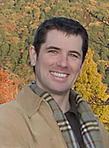Jeffrey E.F. Friedl's Blog, page 29
May 19, 2015
Looking for Modern Bifocal Sunglasses….
I'm surprised that no one seems to make bifocal sunglasses for use in
reading a phone or tablet screen. I'd think that this would be a popular
product among the technically-savvy over-40 crowd.
I've been trying this pair of bifocal
sunglasses for a few weeks, and while they may be great to read a book
with, they're literally worse than nothing when it comes to reading my
iPhone screen because the reading-glasses part is also shaded. The darkness of the screen
makes it less readable than the poorness of my eyesight.
My ideal sunglasses would be clear and unpolarized for the
reading-glasses part, and strongly shaded (and unpolarized) for the
main part. (I don't care for polarized sunglasses when cycling because the
road close up looks different for each eye, and it makes me a bit
queasy; for scooter or driving, polarized is nice.)
In searching both US and Japanese websites, I found one pair like this
for pilots, but the shape/style wouldn't be appropriate for cycling. Otherwise absolutely nothing.
Anyone know of such a product?
Little Surprises on a 500-Yen Coin
Nikon D4 + Venus 60mm Super Macro f/2.8 — 1/15 sec, f/8, ISO 1600 —
map & image data — nearby photos
Japanese 500-Yen Coin
After including the above photo on “Thoughts on the
Venus/Laowa 60mm f/2.8 Super-Macro Lens” in February, it was pointed
out to me that the coin includes some visible security features that I'd
never noticed.
At the bottom of the zero in the middle, the lower-most horizontal line is flanked
on each side by a letter “P”...
Nikon D4 + Venus 60mm Super Macro f/2.8 + 68mm extension tubes + 2x teleconverter, somewhat cropped — 1/60 sec, f/8, ISO 2000 —
map & image data — nearby photos
This shot was taken with an 8:1 macro setup
that falls into the “stupid tricks” category, using extension tubes and a teleconverter. The
accumulated chromatic aberration turns the cold monochromatic metal
into a squishy field of splotchy color. But it was fun to try.
The other digits have two letters each as well: the other zero has “O” and “N”, and the five has “N” and “I”...
N · I · P · P · O · N
Together they spell “Nippon”, which is one way to write “Japan” in roman letters.
Then you have the hatchmarks that fill the two zeros. Depending on the angle of view and the
angle of light, you might get just hatchmarks filling everything....
Nikon D4 + Venus 60mm Super Macro f/2.8 — 1/60 sec, f/22, ISO 2000 —
map & image data — nearby photos
... or you might get proper zeros with a center...
Nikon D4 + Venus 60mm Super Macro f/2.8 — 1/60 sec, f/22, ISO 2000 —
map & image data — nearby photos
... or you might get the phrase “500円” written top to bottom....
Nikon D4 + Venus 60mm Super Macro f/2.8 — 1/60 sec, f/22, ISO 2000 —
map & image data — nearby photos
The rear of the coin also has some of these kind of things, but they're
much more difficult to see there.
I'd like to try taking these photos again more carefully, but I'll wait
until I get a 500-yen coin in better shape than what I could find around
the house the day I took these.
May 17, 2015
Architectural Details at the Kyoto Imperial Palace
Note: this article may not appear properly in news readers.
This article contains interactive aspects that are likely removed by most news readers. Please see this particular article directly on Jeffrey's blog for full functionality.
Nikon D4 + Voigtländer 125mm f/2.5 — 1/400 sec, f/5.6, ISO 320 —
map & image data — nearby photos
Lacking in Color
large building at the Kyoto Imperial Palace, Kyoto Japan
during a visit last November
京都御所、去年の秋
Nikon D4 + Nikkor 24mm f/1.4 — 1/400 sec, f/2.8, ISO 180 —
map & image data — nearby photos
Zooming Back for a Wider View
engulfed in vermilion
最近の記事はサイクリングと撮影ソフトばかりので、やっと僕の基本に一雄戻ります。
I've been posting mostly cycling and Lightroom stuff lately, so time to return a bit to my roots with something Kyoto...
Last November I took a tour of the Kyoto Imperial Palace, and at the
time posted “A
Few Photos From The Start of a Visit to the Kyoto Imperial Palace”, but
got sidetracked, as I often do, before posting more. So today I'm picking up from
there with a few architectural shots....
Let's start with a simple wigglegram
of the courtyard
that ended the previous post...
div#dvU79FDxtDxtAcA img { width:690px; height:440px; visibility:hidden; position:absolute; top:0; left:0; border: solid 10px #311}
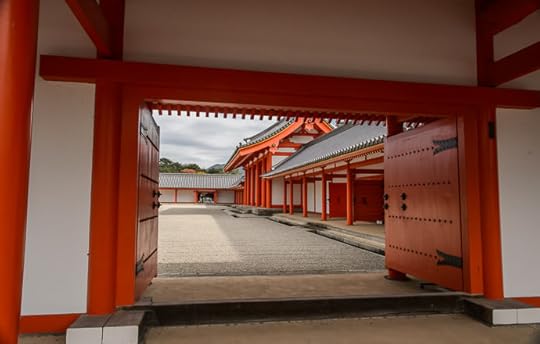
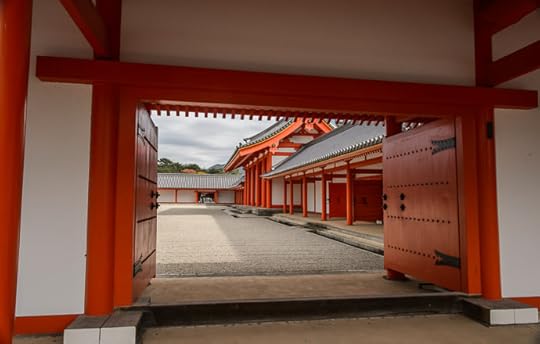
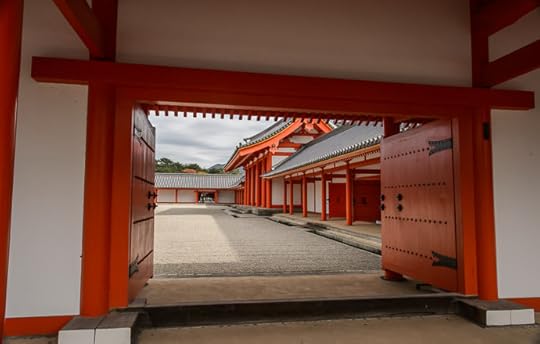
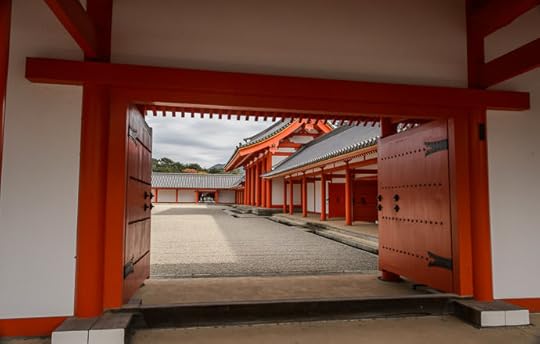
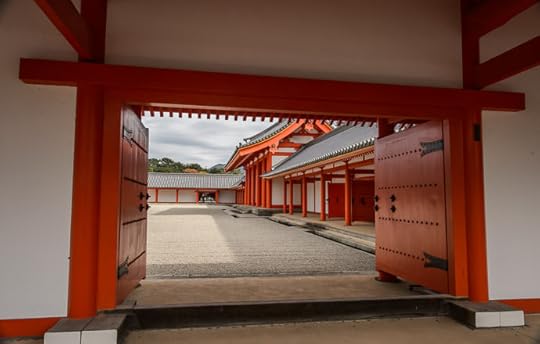
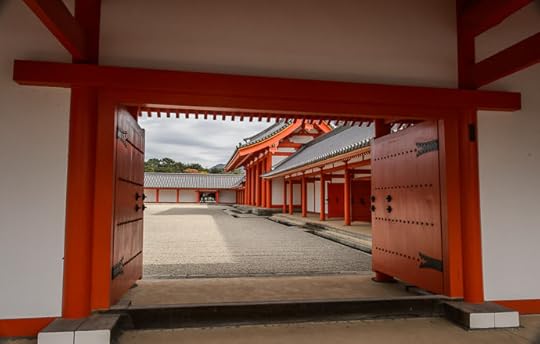
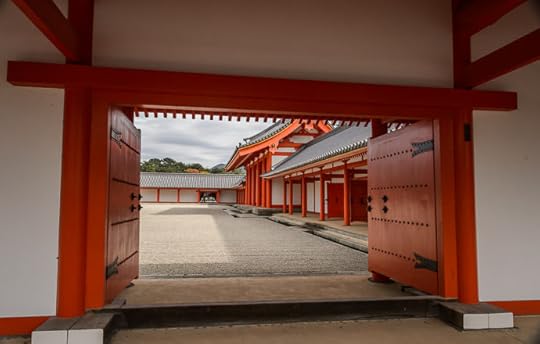
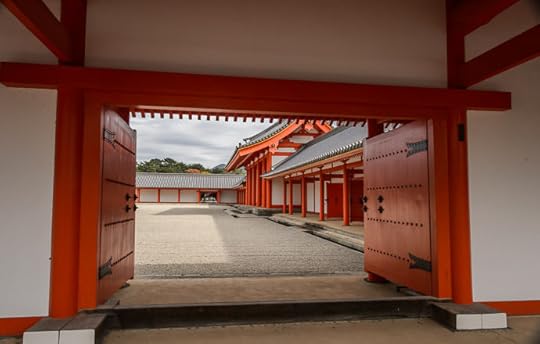
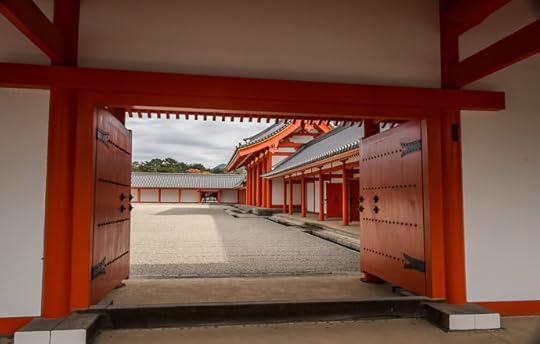
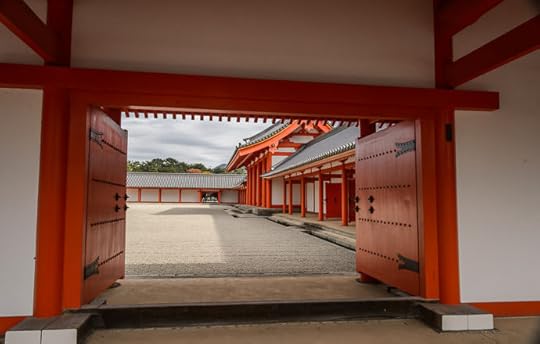
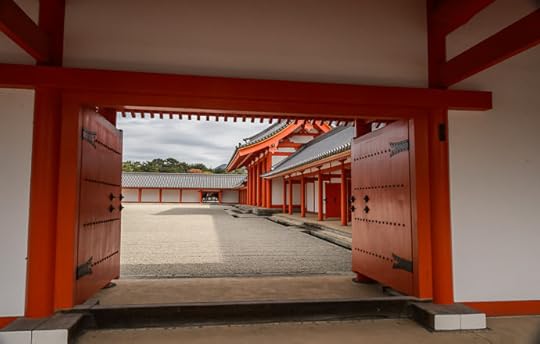
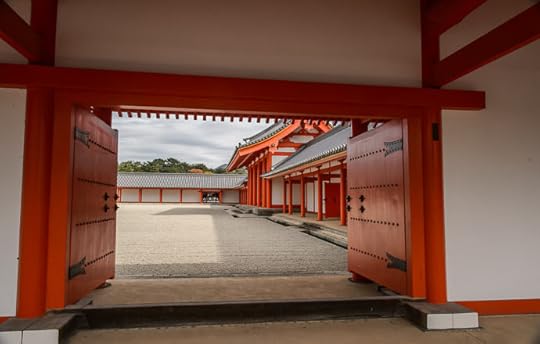
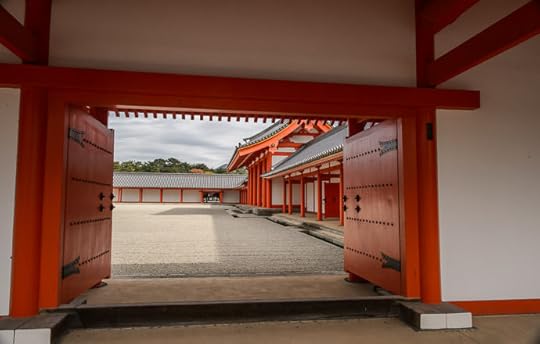
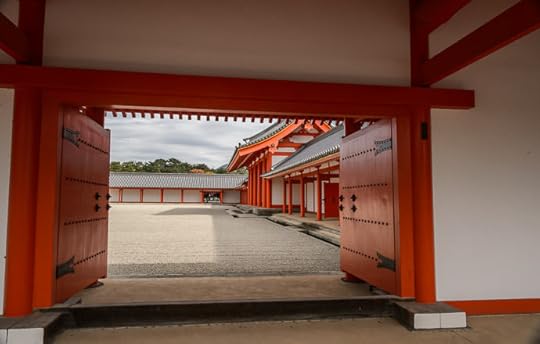
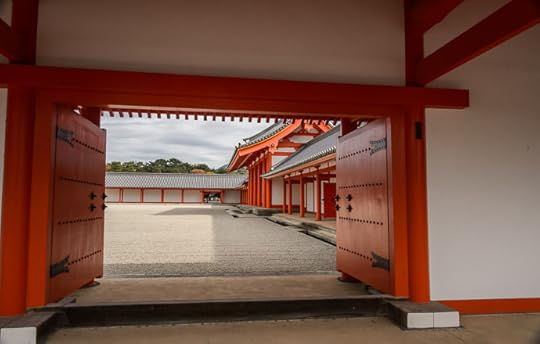
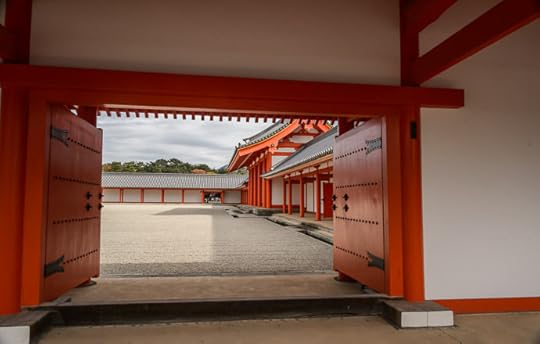
Animatable Wigglegram (16 frames) — slowly sweep mouse from side to side to view 3D effect
写真の上をマウスで左右にゆっくり動かすと「3D」な感じが出ます。
=i.length)return 0;else return which;}else{if(which=i.length)return i.length-1;else return which}};t=function(event){if(m>0&&((new Date().getTime())-m)R&&s0){f(c(s-1));console.log(s+":delta is "+delta);L=0.05;R=0.2;T=tilt;}}};d.ontouchmove=d.onmousemove=function(e){if(e.touches&&e.touches.length>1)return true;var x=Math.floor((e.clientX||e.pageX)/BW);var which=c(x>l?s+(x-l):s-(l-x));l=x;if(which!=s){m=new Date().getTime();f(which);}return false;};window.addEventListener('devicemotion',t,false)}
Looking through, the columns and doors on the wall on the right are pretty...
Nikon D4 + Voigtländer 125mm f/2.5 — 1/400 sec, f/2.5, ISO 100 —
map & image data — nearby photos
Open Doors
Looking straight through to the opposite entrance, I waited quite a while
in hopes of a shot with no one present, but this was the best I could come
up with....
Nikon D4 + Voigtländer 125mm f/2.5 — 1/500 sec, f/2.5, ISO 100 —
map & image data — nearby photos
Almost
almost empty, and almost in focus
Nikon D4 + Voigtländer 125mm f/2.5 — 1/1600 sec, f/2.5, ISO 100 —
map & image data — nearby photos
Roof Detail
the focus being along the ridge seems to give it a slightly odd feeling
Here's a look at the same roof seen in
the previous post, but at different apertures...
div#dop89FJVtJVtNcA img { width:690px; height:455px; visibility:hidden; position:absolute; top:0; left:0; border: solid 10px #311}
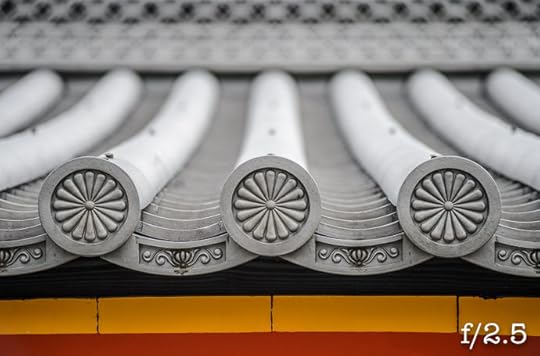
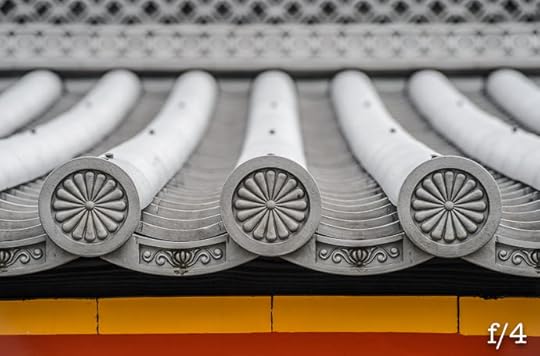
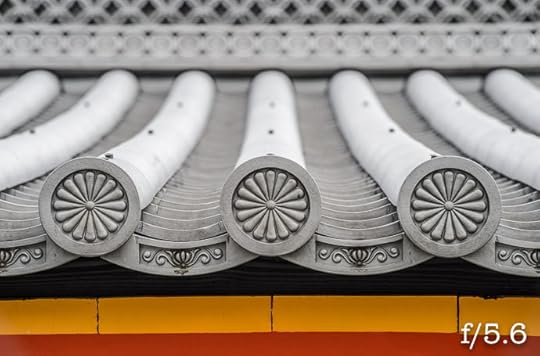
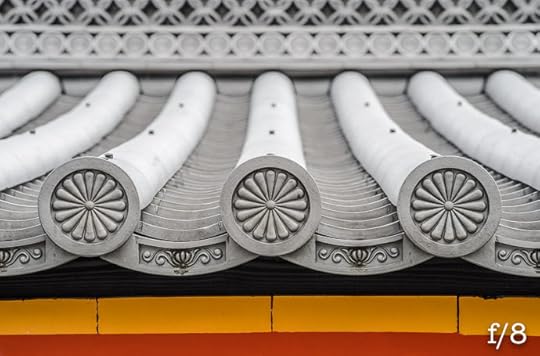
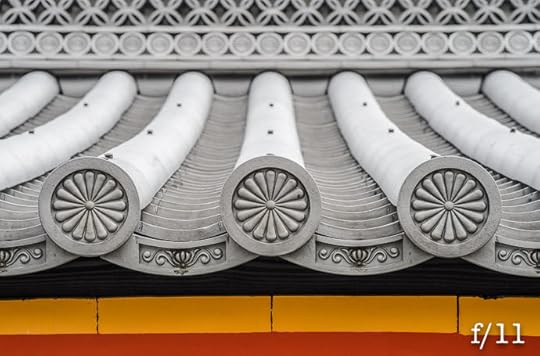
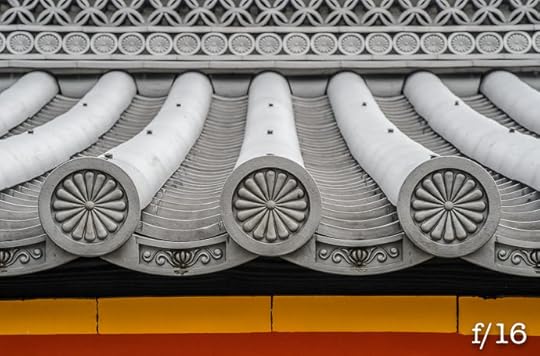
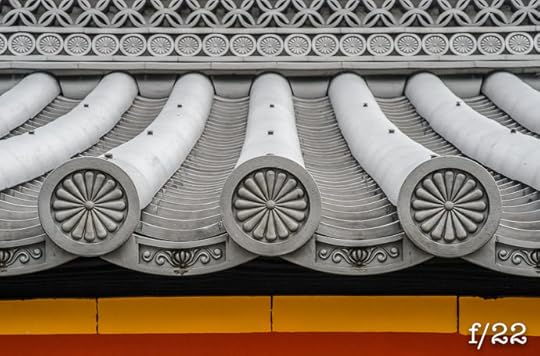
Animatable — slowly sweep mouse from side to side to view effect
写真の上をマウスで左右にゆっくり動かすといろいろな撮影効果を楽しむことができます。
=i.length)return 0;else return which;}else{if(which=i.length)return i.length-1;else return which}};t=function(event){if(m>0&&((new Date().getTime())-m)R&&s0){f(c(s-1));console.log(s+":delta is "+delta);L=0.05;R=0.2;T=tilt;}}};d.ontouchmove=d.onmousemove=function(e){if(e.touches&&e.touches.length>1)return true;var x=Math.floor((e.clientX||e.pageX)/BW);var which=c(x>l?s+(x-l):s-(l-x));l=x;if(which!=s){m=new Date().getTime();f(which);}return false;};window.addEventListener('devicemotion',t,false)}
The shots were done handheld, so there's a slight change of perspective
among them that I find unsettling, but perhaps it somehow gives a sense of 3D?
This impromptu depth-of-field comparison joins half a dozen others I've done in the past, with
a bridge railing,
tea and sweets,
cherry blossoms,
bamboo,
tiny mushrooms, and
moss.
Nikon D4 + Voigtländer 125mm f/2.5 — 1/500 sec, f/2.5, ISO 100 —
map & image data — nearby photos
Different Roof Detail
the amount of work that goes into these roofs boggles the mind
And finally something a little softer than all these architectural details...
Nikon D4 + Voigtländer 125mm f/2.5 — 1/400 sec, f/5.6, ISO 720 —
map & image data — nearby photos
Photograph of People
Photographing Architecture
These are, of course, the ladies from
“A Wigglegram of Three Lovely Ladies in Kimono at the Kyoto Imperial Palace”.
May 16, 2015
Shocking Discovery at the Top of a Kyoto Mountain
Nikon D700 + Sigma “Bigma” 50-500mm OS @ 50mm — 1/1250 sec, f/8, ISO 560 —
map & image data — nearby photos
Totally Shocking!
( and not just because of my outfit )
I lead my recent post about inaccuracies with consumer
GPS devices with the photo above, but I'm repeating it here to tell a
different story...
In the photo, taken by a passing hiker at the
summit of Mt. Otowa (音羽山) in Kyoto, my fingers are lightly resting on
the bike frame. When touching the bike that way as I was posing for the
shot, my fingers felt a kind of buzzing vibration
sensation, which I thought was odd. The wind was strong, but I
didn't think the gusting would hit the bike's resonate frequency or
anything.
Later, when moving the bike around I got some pretty nasty shocks, which
also seemed odd because I was a long way from the nearest electric outlet. I eventually realized that the smaller the contact between my skin and
metal from the bike, the larger the pain. But unlike a shock from, say,
static electricity, it was ongoing. I quickly learned to not touch the metal parts of the bike.
The reason is apparent in once sense if you see the view in another direction. Here's looking
north toward the city of Otsu:
Nikon D700 + Sigma “Bigma” 50-500mm OS @ 50mm — 1/1250 sec, f/8, ISO 560 —
map & image data — nearby photos
View of Otsu
from the top of Mt. Otowa (音羽山)
This view is remarkably similar to this Google
Earth view from my article about Strava the other day, except that this
photo is worse because of the horribly hazy day, and because of the ugly
power-transmission wires.
They lead to a tower right at the peak of the mountain. Retreating down
the mountain a bit and snapping a photo toward the top, you can see my bike
in the lower right...
Nikon D700 + Sigma “Bigma” 50-500mm OS @ 58mm — 1/1600 sec, f/8, ISO 200 —
map & image data — nearby photos
Ugliness
as Japan does best )-:
The lines simply pass over the mountain and do not in any way seem to be
required to be there, running up and down the most exposed ridges for no
apparent reason other than to destroy the maximum amount of natural beauty
when viewed from either side of the mountain. This is a skill that Japan
seems to excel at.
Anyway, the mere presence of the lines near the bike was enough to give
it a shocking amount of, well, shock. I suppose the flowing electricity
creates a magnetic field, which in turn turns partially back to electricity
in the presence of metal like the bike frame? I wonder whether my iPhone was
getting charged at the same time, as well as my credit cards getting wiped?
I'm not kidding when I say that shocks were painful. I wonder what would
happen to someone with metal implanted in their body (bone screws,
pacemaker, dental filling, etc.).
Apparently nothing, though. A web search reveals articles about the
phenomenon (such as this
and this),
and apparently it's just an inconvenience. Still, a painful one, so I'll
take more care next time. Or maybe I should just switch to a non-metallic
bike... a good excuse for a carbon-fiber bike! 
May 14, 2015
More GPS Cycling Tests: Things are Pretty Bad and There’s Little Hope
Note: this article may not appear properly in news readers.
This article contains interactive aspects that are likely removed by most news readers. Please see this particular article directly on Jeffrey's blog for full functionality.
Nikon D700 + Sigma “Bigma” 50-500mm OS @ 50mm — 1/1250 sec, f/8, ISO 560 —
map & image data — nearby photos
Top of Mt. Otowa (音羽山)
Kyoto, Japan
I made my second cycling run up Mt. Otowa (音羽山) on Wednesday, the first having been two
days prior in the gloomy late afternoon just before a typhoon came through.
Wednesday's was the first afternoon after the mild typhoon passed, so I
expected the air to be really clear (like this and this), so I lugged my Sigma “Bigma” 50mm~500mm
zoom all the way up there, along with the 2×TC to give me a 1,000mm lens.
It was so not worth it... it was the most hazy I'd seen it in ages.
Nikon D700 + Sigma “Bigma” 50-500mm OS @ 100mm — 1/1250 sec, f/13, ISO 800 —
map & image data — nearby photos
Super Super Hazy
I was there for an hour, and could never even find Kyoto Tower
The only things that were sort of clearly visible were close, just near the foot of the mountain.
This is a gas station that I pass by along the way that marks an increase in the steepness of the route...
Nikon D700 + Sigma “Bigma” 50-500mm OS @ 1000mm — 1/1250 sec, f/13, ISO 1800 —
map & image data — nearby photos
Starts to Get Steeper Soon
As the crow flies it's about 2,580m (1.6mi) away, but due to how the road winds up the mountain,
the covered distance is about three times that. It took me about 49 minutes to make it from there,
and about 23 minutes to make it back down.
(If find it shocking that the return trip takes only half the time; it feels like it takes about 1/10th the time.)
In the spirit of “The Voodoo of Elevation Gain
and Strava (and How I Get Around It)”, I brought three GPS/GLONASS
units with me, using various ways to extract nine different tracklogs...
DeviceTracklogs
Apple iPhone 6+
Via the Strava app.
Via Abvio's Runmeter app.
Via the Runtastic app.
Via the Galileo Offline Maps app.
Garmin eTrex 20downloaded from the device
Bad Elf GPS Pro +
Downloaded via their app, with GPS elevation.
Downloaded via USB, with GPS elevation.
Downloaded via their app, with barometric elevation.
Downloaded via USB, with barometric elevation.
Now in theory, all four iPhone apps should produce the same tracklog because they all share the same
iOS Location Services data, but they're all quite different. Runmeter (which is identical to their
Cyclemeter and Walkmeter apps except for the name and icon) has an option to use the iPhone's
barometric altimeter, and as the Voodoo post explains, the Strava app ignores both iPhone altimeters,
but elevation aside, the latitude/longitude tracks among the four should be identical, but they're far from it:
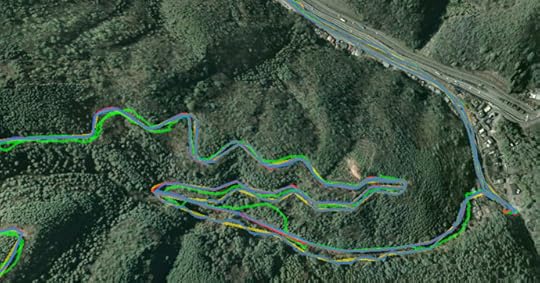
The Four “Identical” iPhone-app Tracks
Part (all?) of the problem is the sampling frequency. Of the four iPhone apps, the most frequent logger is
Galileo Offline Maps, which creates a
datapoint every second when there's obvious movement. The other three apps sample the location “every so often” in
ways that can lead to some big errors. For example, Runmeter's didn't put a
datapoint for where I stopped my ride until more than 30 seconds after I
had stopped, making it look as if I was 30+ seconds slower than I
actually was. Adding 30+ seconds to a segment can destroy the effort (e.g.
a hill-sprint that takes a respectable 90 seconds gets recorded as a pathetic two minutes.)
Even more odd are the four tracklogs from the Bad Elf GPS Pro+. On the plus side, it records a
data point once every second (and can be configured to record 10 per
second!), and also, it records altitude two ways (satellite and
barometric). Because of that last feature, in extracting its data, I'd expect
one track with two elevation profiles, but as odd as it
seems, one can actually derive two different tracks with four
elevation profiles. You see, tracklogs can be pulled from the device via
direct USB connection, or via its iOS app. One
would think that either method is just transporting the same data,
but they inexplicably give different data. I then
split each into two tracklogs, one with the satellite altitude, and
one with the barometric altitude. So we end up
with two tracks with four different elevation profiles. Bizarre.
(I so wanted to like this unit, mostly because the company seemed to have a clue and
wasn't Garmin, but with so many little problems like this cropping up, I have to finally admit
that I can't recommend the unit. )
)
Anyway, I have nine tracklogs, and of course none of them agree on the
amount of vertical gain. This problem likely stems from the aforementioned
sampling frequency, and also the data source (barometric or satellite
altimeter) and post processing. Here's a look at the tracklogs, their
resulting plot in Google Earth, and various claims about the vertical
climb: what the app itself claimed, what my software calculates, and what
Google Earth calculates...
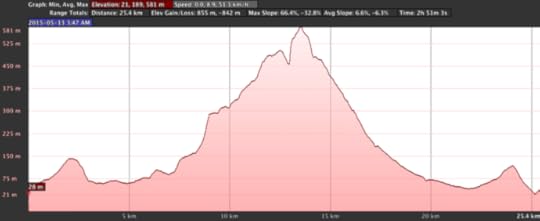
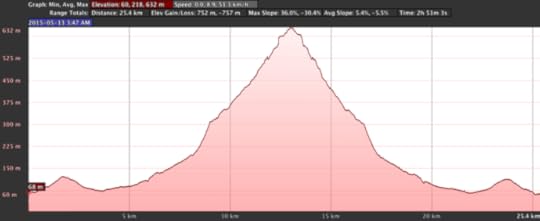
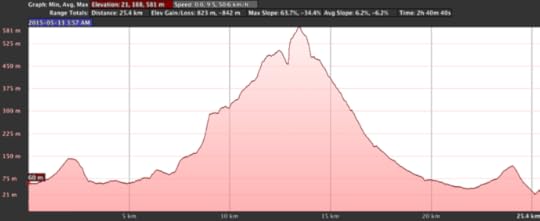
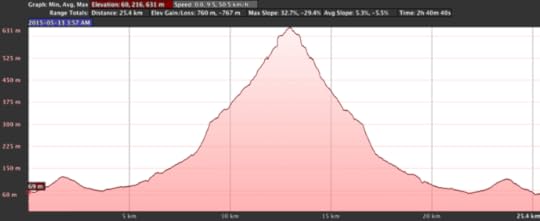
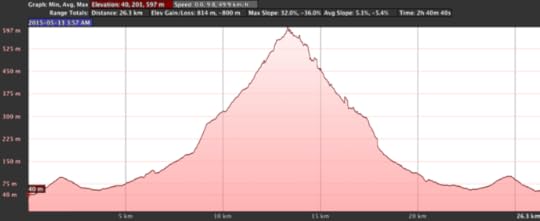
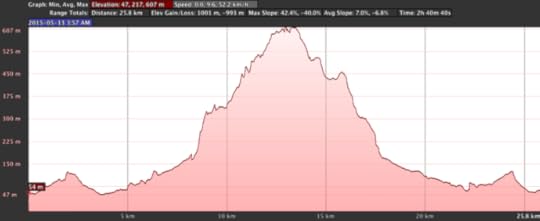
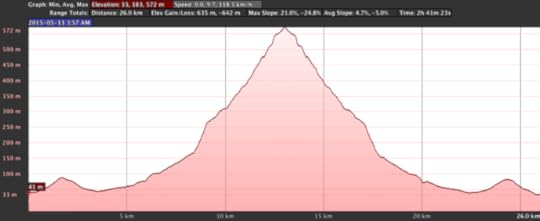
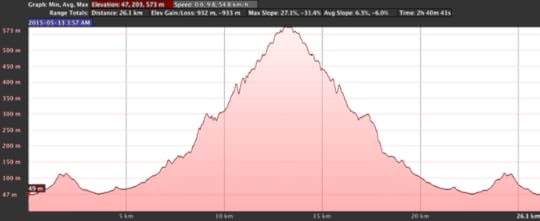
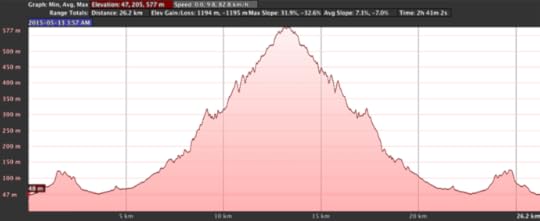
table#t185 td { border-bottom: solid 1px #888; padding: 2px 1em 2px 1em }
table#t185 td:nth-child(2) { text-align: right }
table#t185 td:nth-child(3) { text-align: right }
table#t185 td:nth-child(4) { text-align: right }
table#t185 td:nth-child(5) { text-align: right }
Vertical Gain (meters)
Tracklog
Points
App
Jeff
Earth
iPhone / Galileo
5,243
738
814
iPhone / Strava
3,979
984
1087
1194
iPhone / Runmeter
658
607
582
635
iPhone / Runtastic
2,242
879
863
932
Bad Elf (app/GPS)
9,641
782
855
Bad Elf (app/baro)
9,641
620
752
Bad Elf (USB/GPS)
9,641
782
823
Bad Elf (USB/baro)
9,641
623
760
Garmin eTrex 20
9635
931
1001
The wide variation among results is pretty ridiculous, which is probably an
accurate reflection on the state of consumer GPS, and perhaps why Strava
throws away your elevation data in preference for its data. Sure, Strava's data may
be wildly incorrect, but at least it's consistently incorrect (well,
it has consistency to the extent that a user's two-dimensional location data
— latitude and longitude of each point along the route — is
correct, which is to say that it's not really consistent at all.  )
)
For what it's worth, the shape of the “iPhone / Galileo” elevation
profile looks the most realistic, followed closely by Runmeter and the Bad
Elf barometric. The Runtastic and Strava results are just ridiculous, and
the GPS tracks from the Bad Elf and Garmin units are clearly broken.
It's a sad state of affairs. I'd love to try the test with one of those
$10,000 commercial/professional unit.
So what's the actual vertical climb for this route?
I'm going to say it's 700m (2,300').
The government of Japan makes very accurate laser-derived elevation data
available on this web site. The route from my house up to the top of the mountain can be broken into just a few
up/down segments, whose vertical climb can be easily derived by comparing
the elevation at the start and end:
li.ed { color: #8D8 }
li.eu { color: #D88 }
Front door to Sanjo St: down 2m
To top of Keage hill: up 51.8m
To low spot just before turnoff to old Sanjo: down 46.5m
To the gas station seen above: up 35.9m
Underpass below Rt 1: down 4.8m
To high point at trail entrance at end of road: up 423m
Tiny/steep downslope near start of trail: down 7m
To top of mountain: up 110.5
The “ups” are the vertical climb on the way there, and the “downs”
become climbs on the way back, so just adding them all together gives the
total: 681.5m
This is an absolute lower bound... the vertical climb will be more if there were
rising slopes that I forgot about.
I do know that there were a few spots on the steep road up the mountain
where it leveled off for a while, and even went
slightly downhill for some time (short reprieves certainly appreciated).
I couldn't measure these well on the web site
because I didn't remember their exact locations,
but let's say there were four of them and the elevation loss was just 2m
each, then that adds 8m (4×2m) that we have to re-climb on the way
up, and the same for the way down, so that leaves us with a calculated 697.5m. It's
probably a bit more than that due to
fluctuations on what seem flat sections, so let's round it up to 700m and
call it a day.
In the end, I uploaded a smoothed version of the Galileo track to Strava,
where it appears as
“Otowayama #2 (音羽山その二)”
with a vertical climb pulled out of thin air as 771m.
May 12, 2015
Visiting Kyoto’s Fushimi Inari Shrine with Matt Campagna and a Super-Wide-Angle Lens
Nikon D4 + Nikkor 14-24mm f/2.8 @ 14mm — 1/500 sec, f/4, ISO 250 —
map & image data — nearby photos
“Environmental Portrait”
Matt Campagna at the Fushimi Inari Shrine, Kyoto Japan
It's been three weeks since I posted
“Matt Campagna Wigglegrams Kyoto”,
so I'm finally getting around now to posting other photos from that outing, where I met
fellow Lightroom developer Matt Campagna while he was visiting Kyoto.
Our plan was to visit the Fushimi Inari Shrine,
and since I'd been there for photoshoots many times
(most recently with former Yahoo! co-worker
Andrei Zmievski,
and The Japan Times columnist Alice Gordenker), I thought I'd try something different this time.
Unless I'm going out on
a bike ride or other special situation like a heavy snowfall, I tend to bring three lenses, all primes: a 24mm wide-angle, a 50mm or 85mm medium
angle, and my favorite lens, the Voigtländer 125mm. But for this outing with Matt, I thought I'd give a super-wide-angle lens a
try, so I brought a 14-24mm zoom (along with the 85mm f/1.4 for
portraits).
Nikon D4 + Nikkor 14-24mm f/2.8 @ 14mm — 1/500 sec, f/18, ISO 400 —
map & image data — nearby photos
Main Entrance
Fushimi-Inari Taisha Shrine (伏見稲荷大社)
Nikon D4 + Nikkor 14-24mm f/2.8 @ 14mm — 1/500 sec, f/16, ISO 450 —
map & image data — nearby photos
Matt
a bit apprehensive moments after we met for the first time
Nikon D4 + Nikkor 14-24mm f/2.8 @ 14mm — 1/500 sec, f/18, ISO 220 —
map & image data — nearby photos
Unsettling
Part of the goal in bringing the wide-angle lens was to force me to use
it, to experiment. One expects some distortion with a wide-angle lens, but
when taken out of context by an uncentered crop like the shot above, the result can be a “off”
in an unsettling way.
For reference, here's the unedited/uncropped version of the shot above.
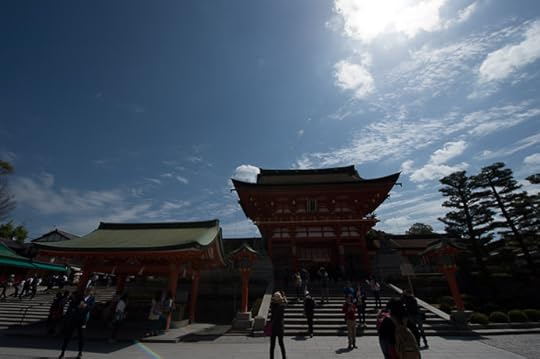
Nikon D4 + Nikkor 14-24mm f/2.8 @ 14mm — 1/500 sec, f/18, ISO 220 —
map & image data — nearby photos
original unedited/uncropped version
Nikon D4 + Nikkor 14-24mm f/2.8 @ 14mm — 1/500 sec, f/18, ISO 2000 —
map & image data — nearby photos
Less Unsettling
This shot clearly has distortion, but it's not unsettling to me, I suppose, because
the crop is more centered...
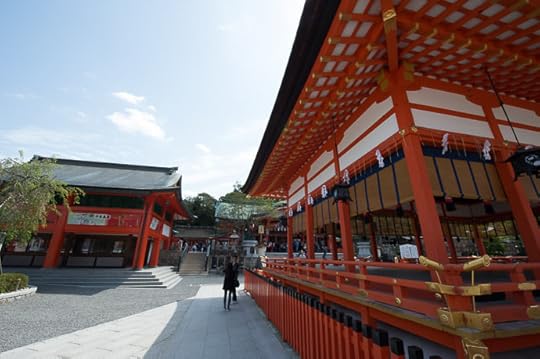
Nikon D4 + Nikkor 14-24mm f/2.8 @ 14mm — 1/500 sec, f/18, ISO 2000 —
map & image data — nearby photos
original unedited/uncropped version
Nikon D4 + Nikkor 14-24mm f/2.8 @ 14mm — 1/1000 sec, f/3.5, ISO 100 —
map & image data — nearby photos
That's a Mighty Big Camera You've Got There...
Matt's smile is what grabs and holds the attention in this shot, but once you notice how big the camera has become,
it's hard to unnotice. He's holding a Nikon D4, the same as I'm using.
Nikon D4 + Nikkor 85mm f/1.4 — 1/400 sec, f/1.4, ISO 6400 —
map & image data — nearby photos
Green Tea
and green face
We stopped at a cafe for a cool drink, and with a lot of leaves just
outside the big windows next to us (as seen in this shot of the
same table), there was a green cast over Matt's face. The green is all
natural, coming from all the foliage outside and all, but ever since this experience with
low-quality lights I've been sensitive to a green color cast, and want
to remove it.
I took a closer portrait shot, and in Lightroom tried to reduce the level of green...
Nikon D4 + Nikkor 85mm f/1.4 — 1/500 sec, f/1.4, ISO 2200 —
map & image data — nearby photos
Less Green
Nikon D4 + Nikkor 85mm f/1.4 — 1/500 sec, f/1.4, ISO 4000 —
map & image data — nearby photos
More Grin
Nikon D4 + Nikkor 14-24mm f/2.8 @ 14mm — 1/500 sec, f/2.8, ISO 640 —
map & image data — nearby photos
Another “Environmental”
perhaps this is what a super-wide-angle is best for
Nikon D4 + Nikkor 14-24mm f/2.8 @ 14mm — 1/500 sec, f/2.8, ISO 1250 —
map & image data — nearby photos
Completely Lost
The “lost” in the caption refers not to directions around the sprawling
shrine complex, but to the amazing sense of hidden wonder and escape that
this specific location had... that sense is lost in the photo, which has little
to recommend it beyond the journalistic statement that Matt was at that location.
I'll have to put some thought in how to capture that sense.
Nikon D4 + Nikkor 14-24mm f/2.8 @ 14mm — 1/500 sec, f/4, ISO 3200 —
map & image data — nearby photos
Farther Inside
precariously close to the splashing stream of water
I'm not a big fan of wide-angle lenses, probably because I don't have an innate sense on how to use it well,
nor enough practical experience to overcome the lack of instinct. Still, in
the seven years I've had it, I've posted 140 photos with it at its most wide
angle (14mm), and have added 11 more today. I seem
to like it best for the “environmental”
shots, showing the subject in the wider context of the surrounding
environment.
Here are links to a few random 14mm shots posted over the years:
here,
here,
here,
here,
here,
here,
here,
here,
here,
here, and
here.
May 11, 2015
Gray View of Kyoto from Mt. Otowayama
Nikon D4 + Sigma “Bigma” 50-500mm OS @ 50mm — 1/200 sec, f/4.5, ISO 2500 —
map & image data — nearby photos
Not Much of a Sunset
Mt. Otowyama (音羽山), Kyoto Japan
I've found a new place to try to get nice sunset photos of Kyoto from. Sort of.
For years my go-to place has been the Shogunzuka, which I first posted about almost
eight years ago, but have posted about
many times since. It's a 5-minute drive from my place on a high
hill (small mountain?) over eastern Kyoto.
The small mountain it's on is the little bump going across the center of
the shot above... the mountain I'm on for the shot, Mt. Otowayama, is 593m
(1,950') high and 6½ km farther away. It took me about an hour
fifteen minutes to ride my bike there
this evening. I went in hopes of a nice sunset, but there were only gray
skies in anticipation for a typhoon passing by in a day or two.
Maybe next time.
Nikon D4 + Sigma “Bigma” 50-500mm OS @ 50mm — 1/200 sec, f/4.5, ISO 2800 —
map & image data — nearby photos
My Ride
I'd not known about the place until yesterday when a friend
posted
a photo from the top on Facebook. So today I gave it a try.
One really needs a mountain bike to get there. A closed mostly-paved
road gets you close, but the last little bit is a mountain trail. I had to
push the bike on a few sections of extremely steep trail, but otherwise
could ride most of the way.
I was gratified to break my record on a few of the smaller hills on the
way there and back. Getting the “PR” (personal record) on a ride is sort of
addictive, but also a diminishing resource. I made one today by just one
second, so further records will actually require some effort on my
part....
May 9, 2015
The Voodoo of Elevation Gain and Strava (and How I Get Around It)
Note: this article may not appear properly in news readers.
This article contains interactive aspects that are likely removed by most news readers. Please see this particular article directly on Jeffrey's blog for full functionality.
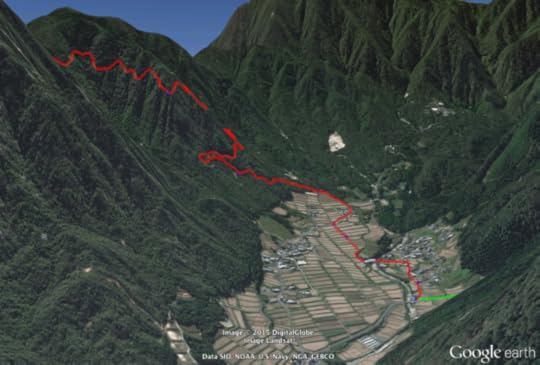
A Light Mountain Climb After Lunch
340m climb from the village of Kurodani, Takashima City, Shiga Japan
高島市黒谷からの山登り
In the screenshot of Google Earth above, you can see the route that I rode my
bicycle last Wednesday... the little bit of green coming in from
the right is a downhill section of road, followed by the long red uphill section
through the tiered rice paddies of the village,
then up the mountain on an old road no longer open to traffic.
I'd ridden 55km (34mi) to get to that point, and would end up riding
72km (44mi) farther before I got home, but ever
since my first “real” ride in
February, I've not been so interested in how much distance I've covered,
but rather, in how much mountain I've conquered. This means the important
statistic for me is how much “vertical
climb” or “elevation gain”
I did during a ride,
the sum of all the rises/climbs/ascents on the route.
And it's not just me... vertical climb is often used as a badge of
achievement for a ride, and seems to get more talk than distance. It's a strong reflection for how tough a route is.
The problem is that it's difficult to figure out the vertical climb for
a particular route, and commonly-used methods are often wildly
inaccurate.
Cyclers I've met record the ride with a GPS unit of some sort
(their iPhone, a bike computer, a runner's watch, etc.) and upload the
data to Strava, a service that allows
you to analyze your activity and share info about it with others. It's very popular and mostly very well done.
For example, I mentioned it in my previous post about a long mountain bikeride
that I did on April 30th, where Strava had informed me that I had beaten my
record for a particularly tough mountain climb:

Data About My Rides
Courtesy of Strava.com
Footnote: I've since beat it again, but by only 10 seconds.
When you upload your data to Strava, they calculate your vertical climb
for the activity, and display it prominently. For example, the
aforementioned first real
mountain ride shows some impressive stats:
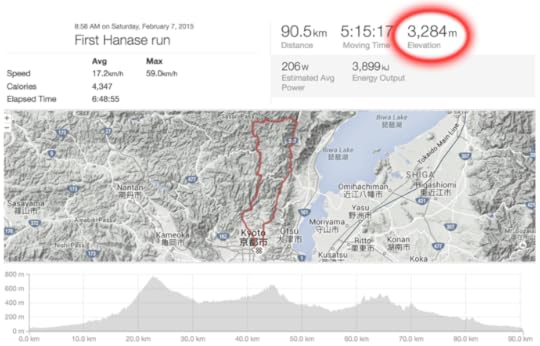
Since it was my first real ride, I didn't know any better but to be
impressed by the 3.3 kilometers (2 miles!) of vertical climb that I'd done. I was amazing. I was Superman.
Unfortunately, it's all a lie.
Over the course of several big mountain rides, I'd started to feel that
the numbers reported on Strava were quite a bit inflated, but I couldn't put
my finger on exactly how.
A week or so ago I posed about another ride, “Short but Intense Bike Ride in Northern Kyoto”, where someone commented
about the apparent discrepancy between reality and what Strava reported
(and hence what I claimed). This spurred me into investigating, and I've
spent the last week digging in, writing tracklog-analysis software, doing
tests, etc.
So, when I went out on a long ride last Wednesday, I brought an
arsenal of equipment with me, recording five separate logs with three
different GPS/GLONASS-equipped devices.
The trip ended up being my longest ride ever, about 125km (78mi), and
also had the most vertical climb I'd ever done in one day. Among the many ways I
recorded the trip's data, I used Strava's mobile
app on my iPhone 6+, and when I was done I had the app
upload all the data to Strava.
Here's what Strava reported about that trip:
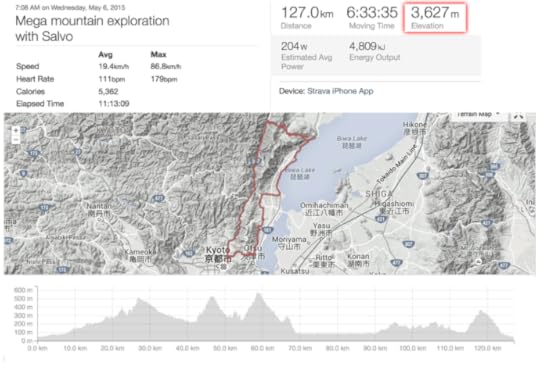
Impressive!
but wrong
The elevation graph at the bottom is an accurate representation of the
11-hour ride, with four separate major mountain peaks transversed, along
with many little ones (though they each didn't seem little at the
time!).
Strava informs me that the trip encompassed an impressive 3,627m
(11,900') of vertical climb. It looks like I started at about 50m and initially climbed to about
500m, and from there went down and up quite a bit
— and believe me, I did — but looking
at the graph it's difficult to come up with a 3,637m sum for all the “up” parts.
In reality, I believe the vertical climb on the trip was about 2,225m (7,300').
First, let's look at why Strava's numbers are so wrong, then let's look
at how to get a better answer.
There are various ways a unit can record your elevation as you travel,
and all of them are generally untrustworthy. Modern units like an iPhone
or a dedicated unit like a Bad Elf GPS Pro+
have three methods to figure altitude: GPS,
GLONASS, and a
barometric altimeter.
GPS/GLONASS can be fairly accurate with your latitude and longitude, as I've discussed in prior
posts, such as
“Informal GPS Logger Test: iPhone 4s GPS is Shockingly Good”
and
“Another Informal Location-Logger Test”.
It's fantastically-amazing technology that is perhaps the only
time we come in contact with something that must actually take into account
Einstein's
general theory of relativity. But it's not perfect, and of the three
dimensions, elevation is by far the least accurate.
Consider these views of three GPS/GLONASS units' tracklogs plotted in Google Earth,
of various sections of last Wednesday's ride:
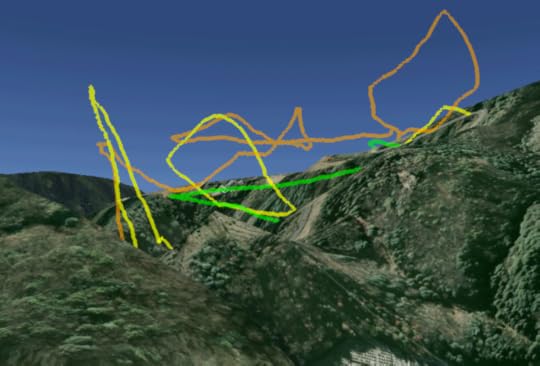
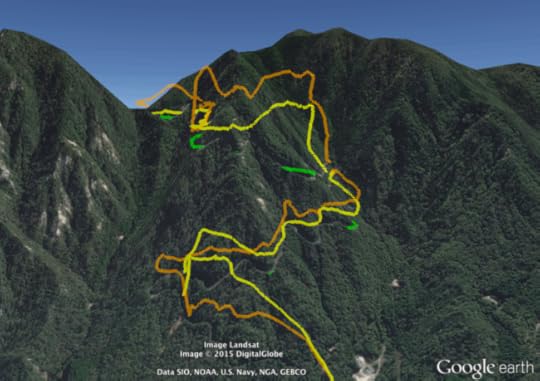
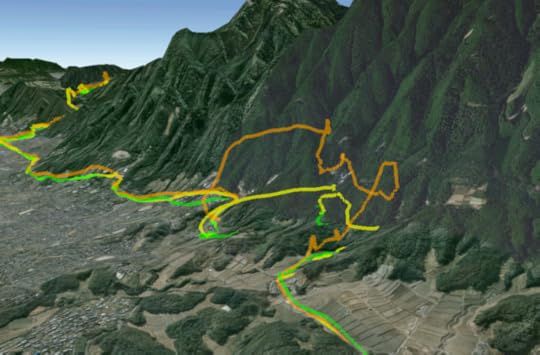
The three units rarely agreed with each other on the elevation, nor any
of them with Google data as seen in Google Earth, and they each in their
own way tended to wander off wildly at times. (The tracks, when viewed
directly from above, all matched up with each other and the road quite
well... it's only the elevation data that was, so to speak, all over the
map.)
When wishing to track vertical climb, the absolute accuracy of a unit is
not particularly important, it's the relative accuracy and stability that
are important, and it seems that barometric altimeters provide better results.
My first experience with a barometric altimeter, on a Garmin GPS unit a decade
ago, was very bad. If there was a breeze or you walked with the unit, it
would record a non-trivial change in elevation (up or down, depending on
how the unit was physically angled relative to the air movement). It was ridiculous.
Things seem better now. On last Wednesday's trip, I had two barometric
altimeters with me, the one in my iPhone 6+, and another on a Bad Elf GPS+.
Here's their plots for the last section seen above:
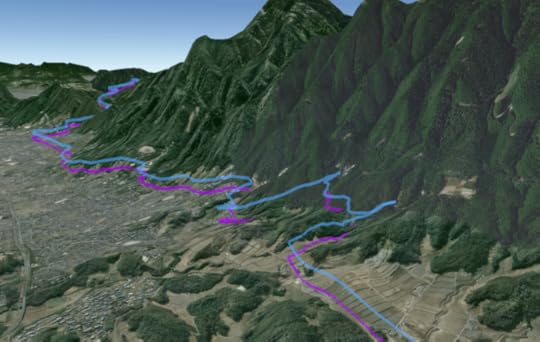
Anyway, a naïve calculation of vertical climb looks at each data point
and, if the elevation of a point is higher than
the previous point, add the difference to the total. Minor errors that
result in small fluctuations over the short term result in wildly-inflated
overall results, but one can smooth the raw data (e.g. with a moving average) to get more realistic results. That's
apparently what Google Earth does, so let's look at what it calculates for
each of my five tracklogs:
UnitTypeGoogle-Earth Vertical-Climb Calculation
BadElf GPS+ GPS/GLONASS3,479m11,414'
BadElf GPS+ Barometric 2,174m7,133'
Garmin eTrex 20GPS/GLONASS3,265m10,712'
Apple iPhone 6+GPS/GLONASS2,215m7,267'
Apple iPhone 6+Barometric 2,009m6,591'
That's quite a range of results from the very same trip. Which is correct?
Frankly, probably none of them.
As we'll see later, there are techniques we can use to eke out some
fairly reasonable results, but first let's see what Strava actually
does...
What Strava Does
Strava's iPhone app has access to both iPhone altimeters (barometric and
GPS/GLONASS), but in the end it uses neither. Rather, it throws away that
elevation data and instead relies on its own database of elevation data
(likely the same data that Google uses to show 3D elevation in Google
Earth).
Strava's approach may well be fine in generally-flat areas, but it produces
ridiculously-overinflated results in the mountainous areas I've checked, and
it's easy to see why...
I created some software to analyze the tracklogs, smooth local
irregularities, and present uphill sections in red and downhill sections in
green. Let's look at the mountain shown in this article's lead photo, a
long climb followed by a long, enjoyable descent down the other side...
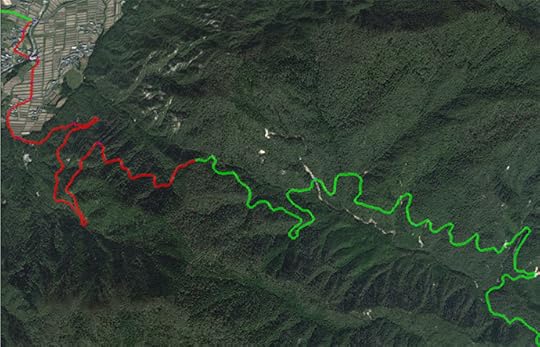
Reality
red means uphill, green means downhill
Both the climb and the descent were quite straightfoward;
the climb was a solid climb without any downhill breaks, and the descent was a solid descent
without any uphill sections. That's why the ascent is a solid red line above, and the
descent is a solid green line.
Now, let's look at how Strava sees it, as well as all my data sources...
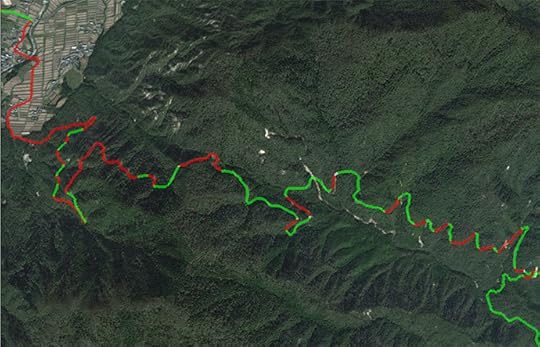
from Strava's elevation data

Bad Elf GPS+ (using its barometric altimeter)
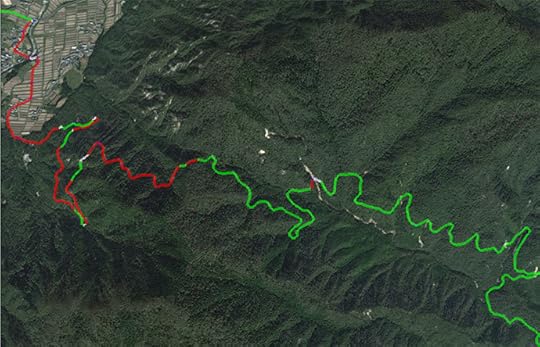
Bad Elf GPS+ (using GPS/GLONASS)
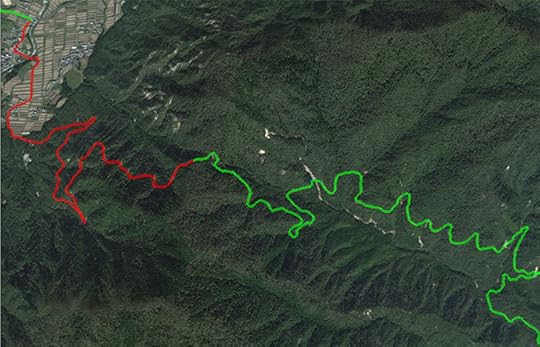
iPhone 6+ using GPS/GLONASS, as recorded with the Galileo Offline Maps app
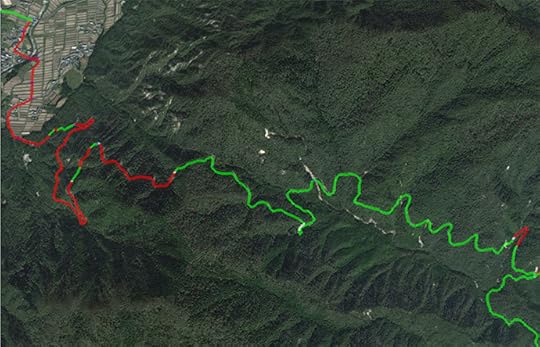
Garmin eTrex 20 (GPS/GLONASS)
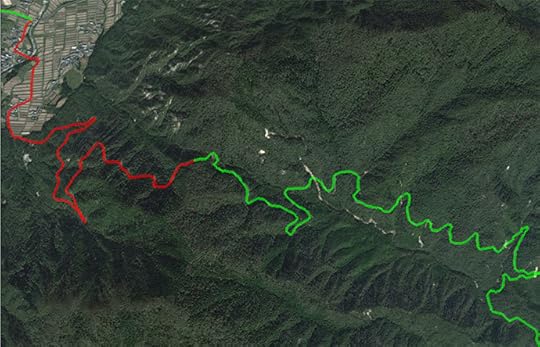
iPhone 6+ using barometric altimeter, as recorded with Abvio's Runmeter app
span.b015 { font-size: small; padding: 2px; border: gray 1px solid }
Strava
- BE (baro)
- Garmin (GPS)
- BE (gps)
- iPhone (GPS)
- iPhone (baro)
mouseover a button to see that image
The Strava data shows many ups and downs on both sides of the mountain... ups and downs that
simply weren't there. It's easy to see why when you look at the mountain in Google Earth (which I believe
uses the same elevation data) from the side. Here's the side of the mountain that I rode down:
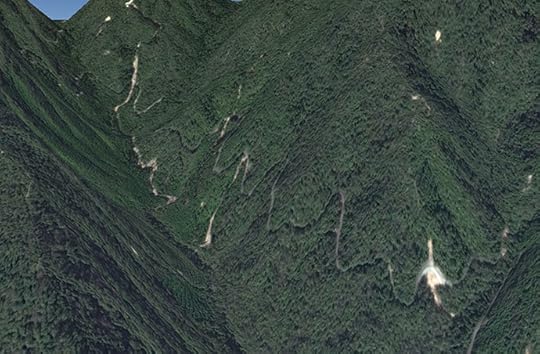
very-3D mountain pressed into a mostly-2D face
The road appears undulate up and down as it makes overall progresses lower, and to Strava,
the “ups” count as vertical climb:
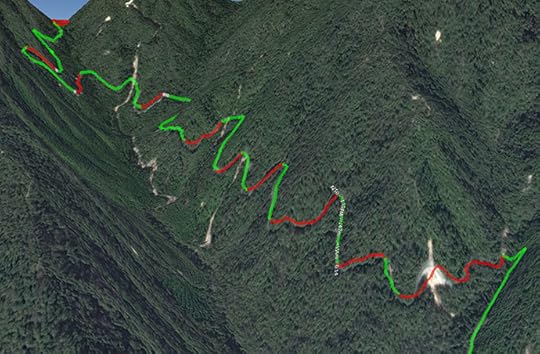
Strava “detects” many false climbs (216m/700' just in this view alone)
Of course, the road doesn't undulate up and down (it progresses “monotonically” down),
but it does undulate
side to side around ravines cut into the side of the mountain by eons of water and wind. You can sort of see the proper undulation in this path created with a barometric altimeter:
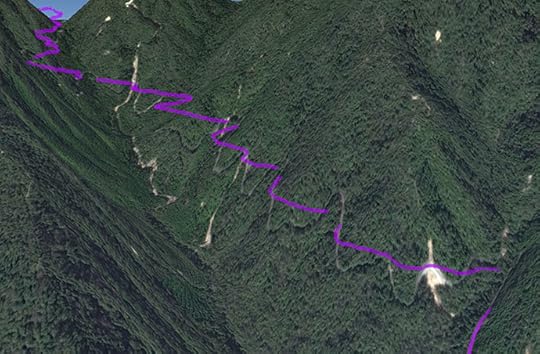
descending around ravines that do exist, but which aren't presented in Google Earth
I should be clear that I'm not complaining about Google... the resources
they've freely gifted to the world in Google Earth and Google Maps
continues to amaze me, and I'm extremely thankful for them.
I'm not quite sure that I'm complaining about Strava. Perhaps these
easily-avoidable inflated results are particular to my area of Japan, and
the rest of the world enjoys added accuracy due to Strava's policies. I don't know. But I do know
that a lot of folks around the world complain
about Strava's inflated elevation claims, so at least I know that I'm not
alone.
So How Can We Do Better
First of all, I should note that Strava does respect the recorded
elevation in some situations where it recognizes that the data was recorded
with a barometric altimeter. Their own iPhone app, however, either doesn't
use the barometric altimeter or doesn't notice that it does, so users get stuck
Strava's elevation data.
Where Strava does accept a device's elevation data, they offer the user
a way to get “corrected” data, whereby Strava throws away the user's data
and replaces it with their inaccurate elevation-database data. This results
in a much less accurate result for many folks, but they offer no way to
undo this action, so if you bump the link by accident, you're hosed.
They also don't allow you to toggle between your device elevation data
(barometric or not) and their data. It seems that they really want to push
their data, and who can blame them? Folks like me early on, ignorant of the
hyper-inflated vertical-climb data, get an ego boost from seeing the big
numbers. I suppose boosted egos help their business interests.
(I'm thankful for their service, which I have enjoyed without cost. I just wish this aspect were better.)
Luckily, one crack in their anti-reality armor is that they allow geeky
types like me to create tracklogs with other devices, then modify
the tracklog to force Strava to accept the elevation data as is, and upload
that.
Massaging Tracklog Data
I've spent the last few days writing software to analyze tracklog data,
to smooth it out, and to derive meaningful information from it.
The first step is to identify when you're stopped, because if you're not
moving, you should have no elevation gain or loss, no speed... nothing.
You're stopped.
Unfortunately, GPS receivers tend to record drifting locations when
stationary, such as the hour I spent visiting
someone (this
sweet lady) in the mountains along the way on Wednesday's long ride:
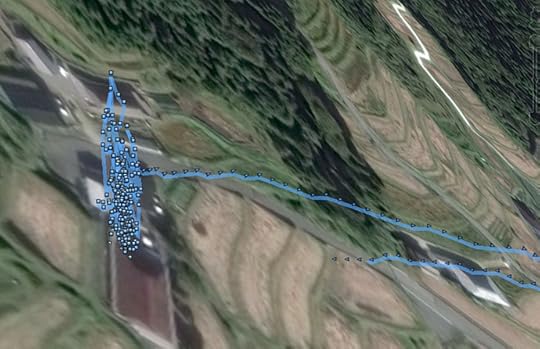
this is what an hour's complete lack of movement looks like
My analysis figured out that all that movement didn't really get me anywhere, so it filters it out
and marks the stopped location with a little blue ring:
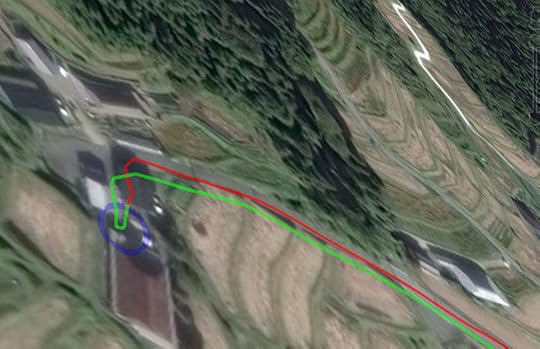
“pause” detected
I have my software note the length of the pause in the KML label, like this:

My pause detection seems to be highly accurate, and I compared its
results with the reality that I remembered on the trip, and it's pretty much perfect. It even accurately detected a 10-second pause at an intersection waiting for a few cars to clear
before I crossed over:
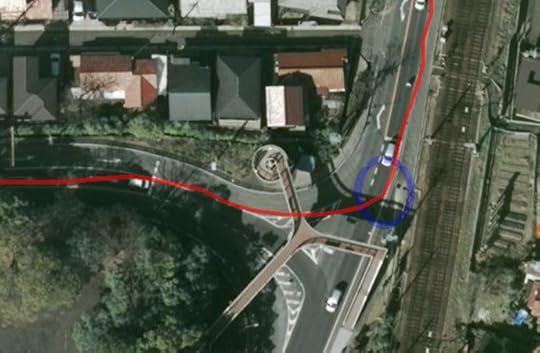
10-second pause for traffic
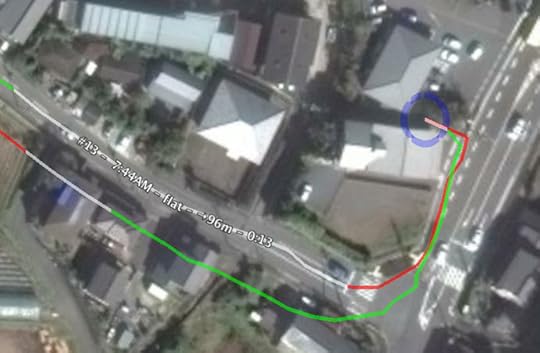
45-minute pause wandering in and around a convenience store
while waiting for a friend to join me on the trip
Then my software goes through the entire trip to find the highest peak
and the lowest valley, and pin the elevation at those locations. That
divides the whole trip into four parts, each of which is subject to the
same analysis, and this analysis recurses (repeats onto itself) over and
over until the difference between a local peak and a local valley is almost
within the range of noise.
Once all these local peaks and valleys are found, the elevation of all
the points in between are smoothed using a moving average. The elevation of
each peak/valley point is left undisturbed, and it's the elevation rise
between them that adds up to the trip's vertical climb.
After all this analysis, the software prepares a KML file that shows
the trip, with red lines for climbs, green for descents, and white for flat sections
(and, optionally, the blue circles for pauses). Here's one view of the second half of my trip:
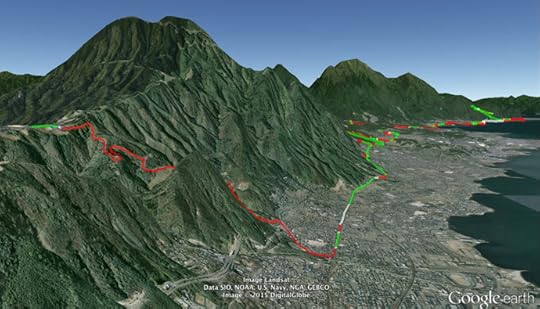
Looking North up the eastern side of Lake Biwa
The red line at the far right ends at the Shirahige Shrine (seen here in the
report on a ride two weeks ago), which we visited briefly after having come
over the mountain, before turning south to ride home.
The distance from the shrine in the background to the spot in the
foreground where the route turns 90 degrees and pitches up into the
mountains is 30km (18mi) as the crow flies, which I mention for scale.
Here's the whole 125km (78mi) trip:
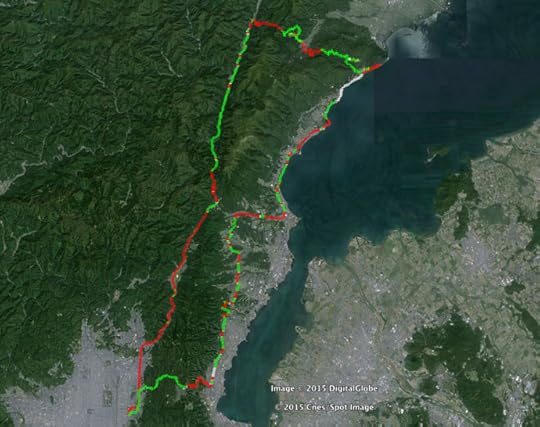
If you'd like to see it yourself, you can download the KML file
(with pauses /
without pauses)
to view in Google Earth.
The “with pauses” view is best for me when I want to “relive the experience”, and I can see,
for example,
that I stopped for half an hour — 31:26 — to eat lunch (at this place
that I last visited seven years ago), and then progressed up the mountain stopping at intervals
for photos, to check directions, or to fix a popped chain.
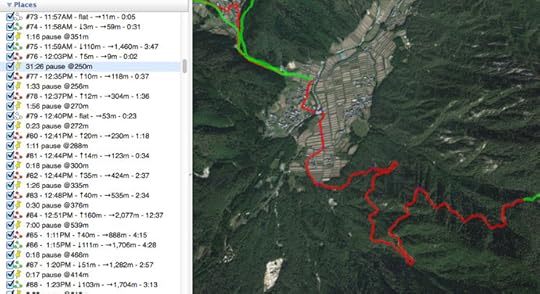
That view is pretty cluttered if all I want to do is analyze whether the vertical-climb data seems reasonable,
so for that the “without pauses” version is better:
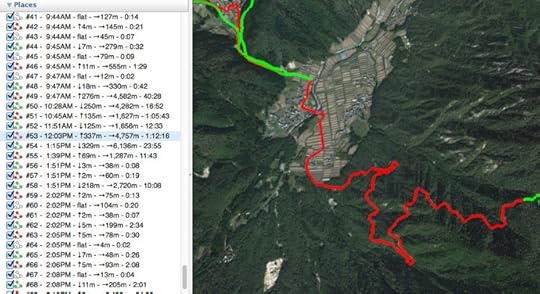
The duration includes all the intervening pauses, rendering it fairly
meaningless, so I should probably simply remove it, but at the moment it's
still there.
Anyway, I did this analysis on all my tracklogs, and found that the one produced
by the Bad Elf GPS+ with barometric altimeter seemed to most match reality, so that's the one
I consider, relatively speaking, “correct”.
And after all this analysis and cleaning and smoothing, I'm left with a tracklog that I (relatively speaking) trust,
so I prepare it so that Strava won't override the elevation data, and upload it. Strava doesn't know that I've
grooomed it, so it does its standard processing, and comes up with this:

They somehow came up with an extra 100m of vertical gain, but since I
truly don't know what the actual value is, I can't say that they're any
less wrong than I am.
So, now that I have the ability to derive a realistic vertical-climb
value, to be honest with myself I must go back and correct prior trips:
table#t2568a td:nth-child(2) { text-align: left; padding-left:1em; padding-right: 0.5em }
table#t2568a td.ft { font-size: small; white-space: no-break }
Date
Event
Vertical Gain
Claimed at the Time
Vertical Gain
Realistic Value
Strava
Inflation
(in feet)
Jan 24
My first tentative outing on bike
N/A
685m
→ 2,090'
Feb 7
My first real mountain ride
3,850m
1,517m
274%
12,630' → 4,620'
March 3
Kuyataki Waterfall with Manseki
762m
540m
141%
2,500' → 1,650'
March 4
Group ride southeast of Kyoto
1,787m
1,282m
140%
5,860' → 3,910'
April 16
“Highly Visible” mountain ride
1,607m
1,180m
136%
5,270' → 3,600'
April 23
Pleasant 105km lake ride
1,300m
?
4,200' →
April 29
Coffee at Cowbell
1,720m
991m
174%
5,600' → 3,020'
April 30
Revisiting my first big mountain ride
3,159m
1,609m
196%
10,360' → 4,900'
I didn't have a good barometric-altimeter tracklog for one of the rides.
The amount of “Strava inflation” is shocking. If I could solve this
problem for myself in a couple of days, you'd think a real company with
presumably smart folks could come up with something.
Anyway, I'll need to find a better app for keeping tracklogs on the
iPhone, one that lets me record both the GPS/GLONASS elevation and the
barometric elevation, and also my heartrate. As it
is now, I'll use a klugy mixture of
various devices and combine all the data myself, massage it, smooth it, and
then send it to Strava.
If they ever get around to addressing this, I suppose that would be a
good time to bring up the next issue: they ignore elevation changes when
calculating distance. They correctly
note that the difference is perhaps at most 2%, but on a 100km ride that can still
be over a mile wrong.
Overall, I guess Strava is just not as anal about statistics as I am...
May 1, 2015
Awesome Cycle Outing: Revisiting My First Real Mountain Ride
DMC-SZ9 at an effective 26mm — 1/250 sec, f/9, ISO 100 —
map & image data — nearby photos
Happy at the Start of a Long Ride
along the Kamo River in Kyoto, Japan
8:51am - taken while moving at 20 kph (12 mph)
photo by Manseki Kanemitsu
If you would have told me half a year ago that I would be riding a
bicycle as far as 10km, I would have never believed you. Bicycles where for
places too close for a taxi or my scooter or a car.
It's amazing how “giving it a try” can change your opinion about something.
On Thursday I retraced the path I took on my first “real” ride last
February, covered in “Attempting a 100km Bikeride in the Mountains of Kyoto, Part 1:
Hanase Pass” and then “Part 2: the Last 70km”. The tough part of this ride is not
the distance, which turns out to be about 92km (57 miles), but the long
unrelenting steep slopes. It was my first real ride because I didn't know
any better... it's a pretty tough ride.
So, three months later I have some experience under my belt, I thought I'd try it again. I was happy to be joined by ironman rider
Manseki Kanemitsu, whom I met two months ago in
“A Bicycle Ride to the Kuuya-taki Waterfall”.
This tough 90+km ride on Thursday followed a ride the previous day that,
though shorter and with less hills, was nevertheless pretty intense. So doing this longer/tougher ride the next very next day felt all the more of an
accomplishment.
DMC-SZ9 at an effective 26mm — 1/250 sec, f/9, ISO 100 —
map & image data — nearby photos
A Beautiful Day in Kyoto
8:53am - taken while moving at 16 kph (10 mph)
photo by Manseki Kanemitsu
I brought along my Nikon D700, which is smaller than my regular Nikon D4, and a
Sigma 35mm f/1.4 lens, but had them packed in the rear bag
at first. I had to pull them out when we stopped to pick up some drinks...
Nikon D700 + Sigma 35mm F1.4 DG HSM — 1/8000 sec, f/2.8, ISO 200 —
map & image data — nearby photos
Always Stylish
Manseki has a coffee before we hit the mountains
9:09am
The route we took (here), like the first time (here), took us up to the same Hanase Pass that I'd done the previous day, so this made my fourth ascent. I had the camera with me, but left it
in the rear pack, so concentrated on the tough climb.
The previous day my main goal had been “don't quit”, and the secondary
goal “don't stop”. I felt good today when I realized that “don't quit” was
now a given and that “don't stop” had become my primary goal.
I was pleased when I returned home to check the stats... I made the main climb
(from Kurama Hot Springs to the pass)
in 36:50, beating the previous day's record by almost two minutes, and
the first time by more than 10 minutes:

New Personal Best!
After descending the other side, I stopped at a vending machine in the next village to get something to drink,
the first of about seven half-liter bottles I ended up buying along the way. And it wasn't even hot (it was about 23°C/73°F).
Nikon D700 + Sigma 35mm F1.4 DG HSM — 1/8000 sec, f/2.8, ISO 200 —
map & image data — nearby photos
Small Village
with the sign for the coffee shop Cowbell
10:41am
The coffee shop that I'd stopped at yesterday was closed, so we continued north.
The farther north we moved, the more the cherry blossoms were still out. We came across a tree with blossoms the same color as Manseki's shirt, so I
had to pull the camera out again...
Nikon D700 + Sigma 35mm F1.4 DG HSM — 1/6400 sec, f/2.8, ISO 250 —
map & image data — nearby photos
Matching
11:00am
Nikon D700 + Sigma 35mm F1.4 DG HSM — 1/8000 sec, f/2.5, ISO 200 —
map & image data — nearby photos
Nikon D700 + Sigma 35mm F1.4 DG HSM — 1/8000 sec, f/2.8, ISO 250 —
map & image data — nearby photos
Nikon D700 + Sigma 35mm F1.4 DG HSM — 1/5000 sec, f/3.5, ISO 250 —
map & image data — nearby photos
Pretty Countryside
11:23am - taken while moving at 25 kph (15 mph)
It was an absolutely-beautiful day in a beautiful countryside, though the photos don't get it across well.
Nikon D700 + Sigma 35mm F1.4 DG HSM — 1/800 sec, f/6.3, ISO 250 —
map & image data — nearby photos
11:27am - taken while moving at 16 kph (10 mph)
Nikon D700 + Sigma 35mm F1.4 DG HSM — 1/1600 sec, f/6.3, ISO 250 —
map & image data — nearby photos
Preparation for Planting
11:28am - taken while moving at 23 kph (14 mph)
The small valleys we rode through were filled with small family farming plots, many busy with activity in preparation for
the next rice crop.
Nikon D700 + Sigma 35mm F1.4 DG HSM — 1/1000 sec, f/6.3, ISO 250 —
map & image data — nearby photos
House in the Countryside
11:29am - taken while moving at 24 kph (15 mph)
Nikon D700 + Sigma 35mm F1.4 DG HSM — 1/1600 sec, f/6.3, ISO 250 —
map & image data — nearby photos
11:30am - taken while moving at 24 kph (15 mph)
Nikon D700 + Sigma 35mm F1.4 DG HSM — 1/2500 sec, f/5.6, ISO 250 —
map & image data — nearby photos
11:32am - taken while moving at 18 kph (11 mph)
Nikon D700 + Sigma 35mm F1.4 DG HSM — 1/400 sec, f/9, ISO 250 —
map & image data — nearby photos
Friendly Chat
Manseki chats with an old lady at the river in front of her house
11:39am - taken while moving at 20 kph (13 mph)
Nikon D700 + Sigma 35mm F1.4 DG HSM — 1/1600 sec, f/7.1, ISO 250 —
map & image data — nearby photos
11:44am - taken while moving at 11 kph (7 mph)
Nikon D700 + Sigma 35mm F1.4 DG HSM — 1/250 sec, f/7.1, ISO 280 —
map & image data — nearby photos
11:46am - taken while moving at 40 kph (25 mph)
DMC-SZ9 at an effective 26mm — 1/250 sec, f/3.1, ISO 250 —
map & image data — nearby photos
Heading Up to Nomi Pass
11:50am - taken while moving at 21 kph (13 mph)
photo by Manseki Kanemitsu
Nikon D700 + Sigma 35mm F1.4 DG HSM — 1/800 sec, f/4.5, ISO 250 —
map & image data — nearby photos
11:51am - taken while moving at 21 kph (13 mph)
Nikon D700 + Sigma 35mm F1.4 DG HSM — 1/2000 sec, f/3.5, ISO 250 —
map & image data — nearby photos
Gutting It Out
12:01pm - arriving at Nomi Pass, elevation 653m
能見峠 (標高653m)の到着
Less snow this time, unlike last time.
This climb is intensely steep for a short distance, but overall much shorter/easier than I remember from the February trip.
Still, I was tired.
DMC-SZ9 at an effective 26mm — 1/1250 sec, f/3.1, ISO 200 —
map & image data — nearby photos
Wasted
photo by Manseki Kanemitsu
For the last few years I've not really needed to eat much during the day, and will often have nothing to eat until evening,
even on days that I do heavy exercise at the gym. But today I was really tired, in the “drained of energy” sense. In preparation for the trip I'd had breakfast, which I seldom do these days, so that I'd have energy, but by this point I was just weary.
So, we paused a bit for the snacks we'd brought...
DMC-SZ9 at an effective 26mm — 1/200 sec, f/3.1, ISO 100 —
map & image data — nearby photos
My Lunch
a natto rice roll
photo by Manseki Kanemitsu
After an all-too-short 8-minute break, we headed down the other side of Nomi Pass. It's very steep and even without snow we couldn't go fast. It took eight minutes to travel the 3km, descending 220m through sharp twisty curves, and it the incessant downward pressure on my
wrists hurt quite a bit.
Nikon D700 + Sigma 35mm F1.4 DG HSM — 1/3200 sec, f/3.5, ISO 250 —
map & image data — nearby photos
Emerging from the Mountain
12:18pm - taken while moving at 26 kph (16 mph)
(compare to this photo in February
Nikon D700 + Sigma 35mm F1.4 DG HSM — 1/6400 sec, f/3.5, ISO 250 —
map & image data — nearby photos
More Pleasant Countryside
12:19pm - taken while moving at 26 kph (16 mph)
Nikon D700 + Sigma 35mm F1.4 DG HSM — 1/3200 sec, f/5, ISO 250 —
map & image data — nearby photos
12:19pm - taken while moving at 36 kph (22 mph)
DMC-SZ9 at an effective 26mm — 1/1000 sec, f/3.1, ISO 160 —
map & image data — nearby photos
“Action Shot” of Me
how I take photos while riding on smooth terrain
12:21pm - taken while moving at 16 kph (10 mph)
photo by Manseki Kanemitsu
Nikon D700 + Sigma 35mm F1.4 DG HSM — 1/2500 sec, f/5, ISO 250 —
map & image data — nearby photos
12:26pm - taken while moving at 19 kph (12 mph)
DMC-SZ9 at an effective 26mm — 1/1000 sec, f/3.1, ISO 160 —
map & image data — nearby photos
Oops
12:30pm - popped my chain, but fixed in a jiff
photo by Manseki Kanemitsu
Nikon D700 + Sigma 35mm F1.4 DG HSM — 1/800 sec, f/5, ISO 250 —
map & image data — nearby photos
Did I Mention
that it was (at times) a really pleasant ride?
12:34pm - taken while moving at 38 kph (24 mph)
Nikon D700 + Sigma 35mm F1.4 DG HSM — 1/6400 sec, f/3.5, ISO 250 —
map & image data — nearby photos
Pause for a Real Lunch
in the middle of nowhere, though technically still in the same ward of Kyoto City where the trip started!
Nikon D700 + Sigma 35mm F1.4 DG HSM — 1/250 sec, f/3.5, ISO 640 —
map & image data — nearby photos
Bon Appétit
at ダイニングcafe いろは
After lunch came my biggest regret, to pack the camera away before
continuing. I thought we were close to Route 367, which I recall as nothing
more than a means to get home (I've taken it many times by car), so I
didn't think there'd be anything photogenic, but it turns out that the next
few kilometers before getting there were the most pretty of the trip.
DMC-SZ9 at an effective 26mm — 1/250 sec, f/9, ISO 200 —
map & image data — nearby photos
About to Arrive to Route 367
1:42pm - taken while moving at 14 kph (9 mph)
photo by Manseki Kanemitsu
Even Route 367 was filled with beautiful scenery that I'd just never
noticed from the car, so eventually I had to pull out the camera...
Nikon D700 + Sigma 35mm F1.4 DG HSM — 1/1600 sec, f/5, ISO 250 —
map & image data — nearby photos
Stacked Wood
on the side of Route 367; 1:56pm
Nikon D700 + Sigma 35mm F1.4 DG HSM — 1/500 sec, f/9, ISO 250 —
map & image data — nearby photos
Pretty Curves
though still uphill at this point
2:06pm - taken while moving at 26 kph (16 mph)
From where we entered Route 367 to Kyoto City proper has six tunnels,
all of which are dangerous on a bicycle when moving from north to south as
we were, because all of them are uphill. When moving away from the city,
the stretches with tunnels are downhill and you can apparently get enough
speed to move with traffic, so don't have to worry (so much) about being
creamed from behind.
When I did this route in February, I had no clue about any of this so I
blindly (figuratively and almost literally) went through the
tunnels, but Manseki's experience and wisdom knew a better way.
Route 367 has likely existed in some form or another for 1,000 years,
certainly from before tunnel technology came to Japan, so each modern
tunnel bypasses an original section of particularly twisty mountain road
that, to some extent, still exists.
Nikon D700 + Sigma 35mm F1.4 DG HSM — 1/640 sec, f/9, ISO 250 —
map & image data — nearby photos
Bypassed Road
2:10pm - taken while moving at 17 kph (11 mph)
The bypassed roads for the two shortest tunnels were impassable due to
construction, but since the tunnels were short, we tried to barrel through
them quickly, making sure our lights were on. (I keep my rear light on
whenever I ride anyway, as a matter of policy.)
Nikon D700 + Sigma 35mm F1.4 DG HSM — 1/640 sec, f/9, ISO 250 —
map & image data — nearby photos
About To (Hopefully) Defy Death
2:18pm - taken while moving at 19 kph (12 mph)
Manseki set a blistering (for me) pace in the tunnel because he has a particular aversion to them, having been sent to the hospital
after getting rear-ended in one some years back. That's at least better than the cyclist who was killed last week in a tunnel in the countryside
south of Tokyo. 
Nikon D700 + Sigma 35mm F1.4 DG HSM — 1/800 sec, f/9, ISO 250 —
map & image data — nearby photos
Turnoff
We were able to bypass the 730m-long Hanaore Tunnel by taking a closed
road that goes up 100m to Hanaore Pass. The road is not passable by car, but
it's still okay by bicycle. We had to lift our bikes over a chain at the beginning
and end.
DMC-SZ9 at an effective 28mm — 1/250 sec, f/3.3, ISO 200 —
map & image data — nearby photos
Plowing Up
2:30pm - the start of a short but fairly steep climb
photo by Manseki Kanemitsu
Nikon D700 + Sigma 35mm F1.4 DG HSM — 1/250 sec, f/9, ISO 1250 —
map & image data — nearby photos
Road of Questionable Condition
2:32pm
Nikon D700 + Sigma 35mm F1.4 DG HSM — 1/250 sec, f/6.3, ISO 800 —
map & image data — nearby photos
Quite Steep
2:35pm - taken while moving at 6 kph (4 mph)
Nikon D700 + Sigma 35mm F1.4 DG HSM — 1/500 sec, f/6.3, ISO 250 —
map & image data — nearby photos
Photo Op at the Top
2:39pm - Hanaore Pass (花折峠)
Nikon D700 + Sigma 35mm F1.4 DG HSM — 1/500 sec, f/5.6, ISO 250 —
map & image data — nearby photos
View of Rt 367
2:48pm - after having descended half way back down
Nikon D700 + Sigma 35mm F1.4 DG HSM — 1/250 sec, f/5.6, ISO 500 —
map & image data — nearby photos
“Stop”
2:49pm - “Best to get off and walk along this section”
He hadn't noticed the rocks at first, having been hidden beneath the accumulated leaves and such, but the rocks
littering the road in this area were of a particularly sharp variety that can easily cause tire punctures, he said.
Nikon D700 + Sigma 35mm F1.4 DG HSM — 1/640 sec, f/2.2, ISO 250 —
map & image data — nearby photos
Sharp Rock
He'd been with half a dozen friends the past weekend on a long (150km)
ride that also encountered this kind of rock, leading to four flats among
the group. My first thought was that I'd ridden on rocks many times without
having given it a thought, but when it comes to cycling I'll certainly
defer to Manseki's wisdom.
And I'm glad I did, because a minute later he realized that he'd already gotten a puncture before stopping me.
Nikon D700 + Sigma 35mm F1.4 DG HSM — 1/4000 sec, f/2.8, ISO 250 —
map & image data — nearby photos
Bubbly Hole
It was a slow leak (he has tubular tires), so he
deemed it safe to ride for a while farther, so we continued down carefully.
We eventually came to see why the road was closed:
Nikon D700 + Sigma 35mm F1.4 DG HSM — 1/3200 sec, f/2.8, ISO 250 —
map & image data — nearby photos
“Lane Narrows”
Once we made it back to Route 367, we were treated to super-twisty high-speed downhill cutbacks that cover
1.1km to transverse less than 200m of distance. Unlike the first time I took these in February, there was no traffic,
so in theory we could really hit them hard, but with his tire situation we took them slower...
Nikon D700 + Sigma 35mm F1.4 DG HSM — 1/6400 sec, f/2.8, ISO 250 —
map & image data — nearby photos
Taking it Easy
2:57pm - taken while moving at 38 kph (23 mph)
After the road straightens out, I stopped to show Manseki the steps to
Kyoto's “I Fall” Tower, which he'd not noticed before. My excuse not to climb the 300+ steps this time was that he had cycling shoes with clips on the bottom. Plus, I was tired.
While we were there, I noticed this guy going the other way (up toward those steep curves)...
Nikon D700 + Sigma 35mm F1.4 DG HSM — 1/250 sec, f/3.2, ISO 250 —
map & image data — nearby photos
Interesting
3:04pm - interesting that he bothered with a reflective ankle bracelet, but no helmet
Anyway, it was time for Manseki to attend to his slow leak by injecting some sealant in...
Nikon D700 + Sigma 35mm F1.4 DG HSM — 1/1600 sec, f/3.2, ISO 250 —
map & image data — nearby photos
Taking the Tire Off
Nikon D700 + Sigma 35mm F1.4 DG HSM — 1/320 sec, f/3.2, ISO 250 —
map & image data — nearby photos
Adding Sealant
Nikon D700 + Sigma 35mm F1.4 DG HSM — 1/2500 sec, f/1.6, ISO 250 —
map & image data — nearby photos
Replacing the Valve
Nikon D700 + Sigma 35mm F1.4 DG HSM — 1/1250 sec, f/4, ISO 250 —
map & image data — nearby photos
Tire Back On
And we were on our way, and in another hour were home.
Back at home, I was tired, but in much better shape than the first time.
Overall it was about 93km, a bit longer than the first time due to going
around the tunnels. It took about as long overall because we stopped often
this time to rest and photograph and just enjoy ourselves (and repair the
occasional tire). All and all it was a great ride.
April 29, 2015
Automatic Face Tagging Now Supported in my Upload-to-Facebook Plugin for Lightroom
I've just released a new version of my Upload-to-Facebook
plugin for Adobe Lightroom that can automatically tag people in photos
you upload to Facebook.
It requires Lightroom CC/6, which was released last week, and
also the latest version of my People
Support plugin, which now allows you to associate a Facebook account
with people in your Lightroom catalog.
Here's an example of how it works....
First, using Lightroom CC/6's facial recognition features, ensure that all faces that you want to tag
are noted within the People view of the Library module.
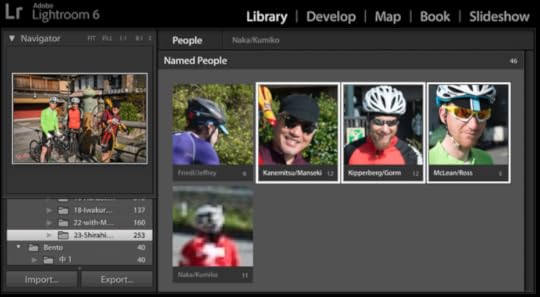
People View
in Lightroom's Library module, with photos from this outing
If Lightroom does not automatically detect everything you want, you can manually add the faces
with the “Draw Face Region” tool, available in Loupe (single-image mode) in Library, as illustrated here:
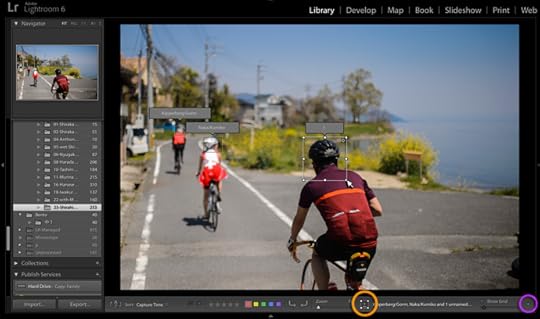
In the screenshot above, I'm in the process of drawing a rectangle around the back of the nearest cyclist's head,
which of course wasn't automatically recognized as a “face” by Lightroom. Nevertheless, I want the cyclist to be recognized
as a Person in my catalog, and to be tagged with his name at Facebook.
The “Draw Face Region” tool is available only in Library's Loupe mode
(the keyboard shortcut to bring up Loupe mode is “E”). The tool is enabled via the
bust-in-a-rectangle icon on the toolbar, highlighted with the orange circle
near the bottom of the screenshot above.
If you don't see the toolbar in Lightroom, you can bring it up with the “T” keyboard shortcut. (“T” again toggles it away.)
If you see the toolbar but don't see the face-region tool icon, either your window is not wide enough to show the icon, or you've
not enabled it for your toolbar. In either case, you can adjust things to your liking by using the little down-triangle icon at the
far right, highlighted with a purple circle in the screenshot. There you can pick and choose what to show in the toolbar.
When you enable this tool, face regions that have already been
recognized are shown, and you can drag out a new region with the mouse, as
I'm doing in the screenshot above. There, I'm about ready to fill in the name
of the foreground cyclist; earlier, I'd drawn and named the background cyclists.
Once I've done that for all the photos that I intend to upload to Facebook, I want to make sure that I've associated
a Facebook account with each person that I intend to tag at Facebook. I do this via my People Support's “Manage Keyword People” dialog,
which I invoke via:
“File > Plugin Extras > Open People-Support Dialog”
(Actually, I use it enough that I've assigned a keyboard shortcut to it, in my case “Control-Option-Command P”.)
The dialog brings up the hundreds of People keywords that my catalog has
accumulated so far, which is overwhelming. I immediately cut this down to
just the people found in the currently-selected photos by entering
“!” in the “Filter” box, as illustrated here:

The “!” is one of the special
search terms that the dialog supports, omitting anyone not tagged in
the currently-selected photos. (Before invoking the dialog, I'd selected all photos I intend to upload.)
I want to make sure that each name has a small Facebook icon next to
it, meaning that I've associated Facebook accounts with all of them. In the example above,
I've not yet associated Gorm with his Facebook account, so I click on his name to do that now:

I click on the highlighted button and paste in the URL for his Facebook profile page,
and now I've got accounts associated with all the people in my next upload.
Finally, in the dialog for my Facebook export or publish, I make sure that I do not strip people information. The option to so do is in Lightroom's standard “Metadata” section of the Publish or Export Dialog:

I make sure that “Remove Person Info” is not enabled, and proceed with
the upload to Facebook. The result is an
album filled with photos with my friends already tagged.
Jeffrey E.F. Friedl's Blog
- Jeffrey E.F. Friedl's profile
- 13 followers


